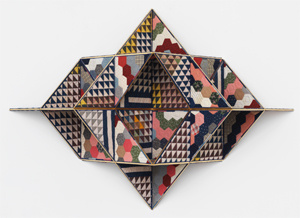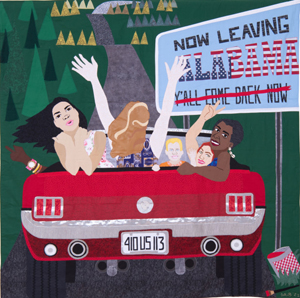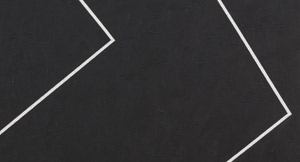A Code for Color
John Haberin New York City
Sanford Biggers and José Parlá
Dawn Williams Boyd and Odili Donald Odita
Sanford Biggers turned to quilts in 2009, on commission to honor a Philadelphia church that had served as a stop on the Underground Railroad. Years later, he is still using antique fabric to bring alternative histories into the present.
At the Bronx Museum with José Parlá, he opens with three pyramidal constructions on the wall. In the most eye-catching, Biggers uses his light wood as a stretcher for what might be samplers and, unmistakably, an American flag. A hidden history vies with public display, for good reason: he is staking African American identity less on politics than on abstract artistry and tradition.  He was never really quilting, no more than another abstract artist in the galleries, Virginia Jaramillo, but he has begun hands-on playing around. Dawn Williams Boyd, in turn, has no interest in abstraction, but her fabric roots political art in African American tradition.
He was never really quilting, no more than another abstract artist in the galleries, Virginia Jaramillo, but he has begun hands-on playing around. Dawn Williams Boyd, in turn, has no interest in abstraction, but her fabric roots political art in African American tradition.
As a postscript, it takes guts to call a show of abstract paintings "Mirror"—or at least a sense of humor. Art, remember, was supposed to be a mirror or window onto the world, and the visual arts can provide a convincing semblance. It takes even more guts for geometric abstraction to go out of its way to break symmetry. So much for the logic of late modern art or the very outlines of a mirror. And what of a painter who adds fields of black, as if to cloud the mirror once and for all? Odili Donald Odita does, to see if his art can comport with his blackness.
Past their bedtime
Sanford Biggers calls his show "Codeswitch," and he keeps switching codes, just as between a woman's craft a black man's claim to America. The title plays on "Codex," as he calls his quilts, most from before 2017. Could they be the source of fabric in his more recent work as well? The 3D construction itself switches codes, between the modular open form of Minimalism and what might be a child's toy, like a glider. It asks to belong both to fine art and the community. So does José Parlá, starting in museum the lobby.
Parlá, who appeared in a show of "Beyond the Streets," boasts of his art as belonging to both the streets and the studio. Once again, too, he rips a slab right off the sidewalks as a centerpiece. Some jerk left his mark in the paving before it dried—and who can say whether that makes it street art or a refusal of community? Parlá himself, born in Miami to Cuban parents, has mostly left the street behind. His collage incorporates ads and maybe a silkscreen or two, but I dare you to make them out. You will spot two words amid the manic energy, Wide Awake, so approach the work with open eyes.
Parlá competes with the big boys in proper male fashion. He has worked on a mural scale before, for the lobby of One World Trade Center, and the largest work here overflows the lobby wall with two layers of unstretched canvas splattered with paint. The work inside the lobby gallery is no small matter either. He employs enamel, but even the predominant acrylic has the sheen of Jackson Pollock. It recalls vinyl for Juan Uslé, but with far less intricacy or form and in brighter colors. He also throws in two work tables from his actual studio.
That call to wakefulness leads naturally to Biggers and his quilts well past their bedtime. A dance video plays out on a low platform, but the real bridge between high and low is in the work. Tapestry can serve as tributes to craft as art, as opposed to fine art and the male canon. And in no time it has entered the mainstream as painting, as for Charles LeDray. With Biggers, it works overtime, hanging everywhere from overhead to the floor. It plays off the floor at that, with cube-like patterns after ancient Roman tiles.
Biggers revels in familiar patterns, geometric or floral, and in their clashing. He heightens them, too, with gold paint and a huge splash of pink. When now and then he sticks to white, it has flickers of glitter as well. As for imagery, who needs it? Only an upside-down building, the center of radiant lines and radiant energy, could point to that church in Philly. But then titles for Parlá speak of dreams and broken promises, whether his or the community's.
Neither artist is above male boasting, as with the figure of a seated warrior for Biggers at his Chelsea gallery. His previous gallery show incorporated gunshots, and SculptureCenter became his "Voodoo Cosmic Circus." Still, the clashes deepen. There is even the remote chance of peace and quiet. A second video starts with disco lighting but ends in contemplation. The modest wood constructions are a welcome beginning or ending.
There goes the neighborhood
Dawn Williams Boyd covers it all. Voting rights, gender rights, Black Lives Matter, the homeless— all are subjects for her painting but only, as her exhibition has it, "The Tip of the Iceberg." The usual suspects parade by for The Death of Democracy, and I do not mean those uppity people of color taking more than their share.  The suspects that keep themselves off the radar have their Smoke-Filled Room. Covid-19 still elicits a scream. Leaving Alabama is the occasion for celebration and a long wave goodbye from the back of a car. But then Boyd and her country have a lot to leave behind.
The suspects that keep themselves off the radar have their Smoke-Filled Room. Covid-19 still elicits a scream. Leaving Alabama is the occasion for celebration and a long wave goodbye from the back of a car. But then Boyd and her country have a lot to leave behind.
They can only be salient issues for a black woman and, I hope, for you. She makes them all the more so in deep black and bright colors on well-stained fabric. Tapestry as painting is trending, for sure, with an homage to folk traditions, but there is nothing naïve to this version of folk art. Boyd has learned her craft and been around. White may play the starkest role of all—in a picket fence, a predatory fish, a dog out for a walk or the hunt, or the pale face of Vladimir Putin with Kim Tok-hun of North Korea on his shoulder. But then George W. Bush has the nails of a vampire behind them, and Donald J. Trump peeks from behind a curtain to steal the show.
It is all that you expected, and that may have you worried. Is she just checking off the boxes? Is she falling instead for the soft, bright pleasures of assorted fabrics, cotton embroidery, Faith Ringgold spaces, and Robert Colescott colors? Maybe she thinks that she can have it all, as two ways of being in her comfort zone—but maybe she can. True, she has no shortage of certainty, not when pollution has reached the point of gas masks, in This Uninhabitable Earth. Not, too, when a boy lies surrounded by police badges in a pool of blood, as In Fear of My Life.
And Boyd values the certainty, but also the tension between the twin comforts. That dead boy lies on the ground, but in the picture plane in as well. She heightens the disorientation, too, in There Goes the Neighborhood. She splits the scene of gentrification in two, with a slight gap between halves that may or may not match up. At the very least, the moving signs are from different companies. Putin and his cohorts carry a casket, presumably of democracy, but whatever are the cotton balls gathering on top?
Her subjects speak of heroes and villains, but the work may not. She has a schoolyard confrontation, with faces pressed close, but black and white share that ride out of Alabama, and paler dark skins or pink flesh tones add nuance. That sign for leaving the state is a highway sign, not a protest sign, and who is to say who has crossed out "Y'all Come Back Now"—the passengers or the state? Boyd can elicit gentler tones, too, in layers of fabric. She can also use them as intermediate spaces past the foreground, leaving the actors neither coming nor going. Massacre on Wall Street has become a literal massacre, with men out for the hunt, but do not be surprised if its exuberance packs a smile.
There goes the neighborhood, then, but a neighborhood all the same, biracial and alive. For one last word, Jammie Holmes sticks closely to his. His living rooms and backyard card game look familiar enough, but the black people within do not seem altogether at home. More than Boyd with her disjunctions, Holmes prefers compressed spaces, although with similar colors and similar results. Unlike her, too, he claims the mantle of the self-taught. Yet her greater experience pays off.
Clouding the mirror
African Americans are as entitled as anyone to make abstract art their own. Think of Howardena Pindell and Vivian Browne—or museum shows of black power and black abstraction. Melvin Edwards is coming to City Hall Park for New York summer sculpture, and Sam Gilliam to Chelsea. At fifty-four, Odili Donald Odita is a worthy successor. I could safely enjoy his past shows as abstract painting and nothing but abstract painting. Could his new work prove me wrong?
Not that the Philadelphia artist has changed all that much, but he obliges one to think about his work anew. Racial identity is at stake even before you enter. Large black type on the window, courtesy of Nick Cave and Bob Faust, tolls the minutes and seconds of the choke hold that killed George Floyd. It is a black picture, in block sans serif, and inside the blackness deepens. Not obviously so, but who needs more of the obvious? Odita thrives on color and confusion.
Hard-edged colors run every which way. They fan out from a painting's center, multiply diamonds into pillars, and allow an overall diamond to emerge. He could keep you more than busy enough with that. Still, his symmetry breaking lets in the black. It might be off to the side, or it might be a large black diamond as a painting's heart. It may serve as ground for the colors, while also adding to the work's flatness. 
Odita shares the gallery with another Nigerian-born artist, Toyin Ojih Odutola. Odutola pairs images of friends with what might be postcards that he sent them. If that leads to some awfully postcard sentiments, Odita has something else in mind. Why, he asks, is he under an obligation to conform to someone else's image of blackness? Besides, he says, "the only face that you will never actually see is your own." Still, painting for him is all about self-reflection.
Artists of the past have incorporated mirrors into their images to enhance or to subvert the truth in painting, like Jan van Eyck and Diego Velázquez—and Gerhard Richter is still clouding the mirror. Odita keeps things crystal clear. Look more closely, and the black areas contain freehand lines in light brown or gray, for the texture of wood grain, fine paper, or, yes, human skin. "Flesh," he adds quoting Willem de Kooning, "is the reason oil paint was invented." Odita could well claim "I am your mirror" as well, confronting the white viewer while one-upping the Velvet Underground.
Virginia Jaramillo, too, has something to reconsider. Born in Mexico, she has exhibited among women of color, but she has even less reason than Odita to think of her art as black. Her last show last used black fields pierced by lines and by color, only the lines were the work's color, as well as its source of energy. Around 1970, though, her mood was quieter and closer to Abstract Expressionism. Soft edges and hints of a horizon recall Mark Rothko, even as abstraction may give way to a faint landscape. In her own way, she is clouding the nature of painting.

Sanford Biggers ran at the Bronx Museum through April 5, 2021, José Parlá through January 10. Biggers also ran at Marianne Boesky through December 12, 2020, Odili Donald Odita at Jack Shainman through October 31, and Virginia Jaramillo at Hales through October 31. Dawn Williams Boyd ran at Fort Gansevoort through December 17, 2022, Jammie Holmes at Marianne Boesky through October 8. Related reviews look at Biggers in 2017 and at SculptureCenter, Odita in 2013, and recent work by Jaramillo.




